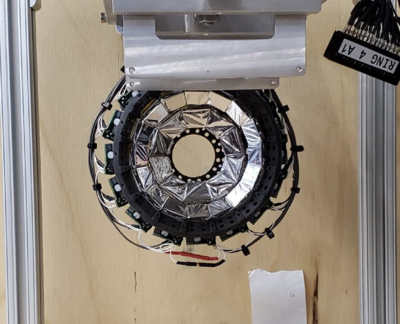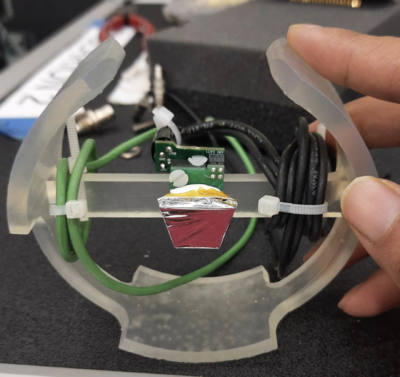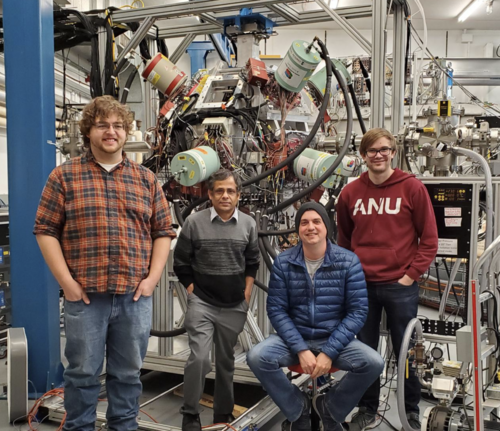Clarion2: Difference between revisions
(→DAQ) |
mNo edit summary |
||
| Line 4: | Line 4: | ||
for '''R'''adioactive '''ION''' beam). It is a 4π gamma ray detectors array with 16 High-Purity Germanium (HPGe) clover detectors. Each HPGe detector is shied with a BGO (Bismuth Germanate <nowiki>[</nowiki>Bi4Ge3O12<nowiki>]</nowiki>) shield. | for '''R'''adioactive '''ION''' beam). It is a 4π gamma ray detectors array with 16 High-Purity Germanium (HPGe) clover detectors. Each HPGe detector is shied with a BGO (Bismuth Germanate <nowiki>[</nowiki>Bi4Ge3O12<nowiki>]</nowiki>) shield. | ||
Each clover detector has 4 crystals, color-coded as Red, Blue, Green, and Black. Here is the angular map for all 16 clovers. | Each clover detector has 4 crystals, color-coded as Red, Blue, Green, and Black. Here is the angular map for all 16 clovers. Further details of the array can be found [https://arxiv.org/abs/2208.05449 here]. | ||
[[File:Clarion2 angular map.png|400px|thumb|none|Clarion2 angular map. The purple dot is the center of each clover.]] | [[File:Clarion2 angular map.png|400px|thumb|none|Clarion2 angular map. The purple dot is the center of each clover.]] | ||
| Line 46: | Line 47: | ||
== Trinity == | == Trinity == | ||
[[File:Front view of TRINITY.png|400px|thumb|right|Front view of TRINITY, photo by Vandana.]] | [[File:Front view of TRINITY.png|400px|thumb|right|Front view of TRINITY, photo by Vandana.]] | ||
Trinity is formed by GAGG ('''G'''adolinium '''A'''luminium '''G'''allium '''G'''arnet) | Trinity is formed by GAGG ('''G'''adolinium '''A'''luminium '''G'''allium '''G'''arnet) scintillator crystals. It is located in the target chamber of the Clarion2. The GAGG crystals are arranged in 5 rings, covering 7-54 degrees. Currently only two rings are implemented, which cover 14-24 and 34-44 degrees respectively. | ||
[[File:A single GAGG detector.png|400px|thumb|none|A single GAGG detector]] | [[File:A single GAGG detector.png|400px|thumb|none|A single GAGG detector]] | ||
| Line 64: | Line 65: | ||
= DAQ = | = DAQ = | ||
The DAQ system is fully digitized with [[Pixie16 digitizer]]. The signals from the Clover and BGO are directly fed to the Pixie16 digitizers. The data processing | The DAQ system is fully digitized with [[Pixie16 digitizer]]. The signals from the Clover and BGO are directly fed to the Pixie16 digitizers. The data processing library developed by Tim Gray can be found at https://github.com/belmakier/libpixie and https://github.com/belmakier/libClarionTrinity . | ||
The Plx driver was modified from the Broadcom driver. The PixieSDK (legacy) was also modified. | The Plx driver was modified from the Broadcom driver. The PixieSDK (legacy) was also modified. | ||
Revision as of 09:37, 12 August 2022
Introduction
Clarion2 is the successor of Clarion (CLover Array for Radioactive ION beam). It is a 4π gamma ray detectors array with 16 High-Purity Germanium (HPGe) clover detectors. Each HPGe detector is shied with a BGO (Bismuth Germanate [Bi4Ge3O12]) shield.
Each clover detector has 4 crystals, color-coded as Red, Blue, Green, and Black. Here is the angular map for all 16 clovers. Further details of the array can be found here.
| Solid work model needed |
HPGe Clover Detector
The detectors are produced by EURISYS Measure, now CANBERRA, owned by MIRION Technologies [1]. An approximate 3.3 kg clover detector consists of 4 coaxial crystals (dimension 50 mm in diameter, 80 mm in length) [Mirion webpage].
Typical photon-peak efficiency curve
The absolute photo-peak efficiency at 1332 keV is ~1.8%.
The equation for the absolute efficiency curve is
GEANT4 simulation
The performance of a single clover detector was simulated using GEANT4. The source code can be downloaded from https://github.com/goluckyryan/HPGeClover.
Trinity
Trinity is formed by GAGG (Gadolinium Aluminium Gallium Garnet) scintillator crystals. It is located in the target chamber of the Clarion2. The GAGG crystals are arranged in 5 rings, covering 7-54 degrees. Currently only two rings are implemented, which cover 14-24 and 34-44 degrees respectively.
Neutron Shield
In 2022 April, a set of neutron shields surrounded Clarion2 for shielding slow neutrons.
Clarion2 private network
The Clarion2 uses its own private network. The network structure is illustrated as following:
Fox's Lab network --- clarion2(Mac, gateway) ---- 10 Gb switch
+--------- clarion2 DAQ
+--------- LN2 control, HV control
DAQ
The DAQ system is fully digitized with Pixie16 digitizer. The signals from the Clover and BGO are directly fed to the Pixie16 digitizers. The data processing library developed by Tim Gray can be found at https://github.com/belmakier/libpixie and https://github.com/belmakier/libClarionTrinity .
The Plx driver was modified from the Broadcom driver. The PixieSDK (legacy) was also modified.
| Detail of operation is needed. |
LN2 cooling system
The liquid Nitrogen (LN2) filling system developed by Mitch Allmond (Oak Ridge) is hosted on the LN2-control computer under the account "ln@ln02".
ln@ln02 Directory
Several important directories for using the LN2 system are listed below.
/gln
/gln is the most important directory, it is where the control program is located and for most problems is where you will need to go
gln_ui
gln_ui is the user interface to issue commands to the fill program
fill <det-list>- fill detectors <det-list> now
fill <det-list> after <number-of-minutes>(or <hours:minutes>)- wait to fill detectors <det-list> by time <hours:minutes>
cool <det-list>- cool down detectors
ton <det-list>- turn on (enable fill for) detectors
tof <det-list>- turn off (disable fill for) detectors
con det#[.temp#]- turn on checking of detector temps
cof det#[.temp#]- turn off checking of detector temps
abort- abort and disable all fills
load [fig-file-name]- load configuration from fig-file-name (default = gln.fig)
exit-master- exit gln_master process
clr- clear all errors for entire system
| Proper usage is to clear individual detectors |
clrd <det-list>- clear errors for specific detectors
clrs- clear all slot errors
clrm- clear all manifold errors
d- display status
dt- display times of all detectors & manifolds (formatted dates and times)
dts- display times of all detectors & manifolds (in seconds)
dc- display configuration (valve and ADC IDs, etc)
mon- enter monitor mode; type control-C to exit
quit- exit gln_ui process
hvln- useless command for backward compatibility
clear- clear screen
?orhelp- help text for commands
Low Level Commands
radc <#>- read ADC number <#>
opv <#>clv <#>- open and close valves
http://clarion02.physics.fsu.edu/~clarion02/index.html
List of Collaborators
The list may not be completed.
| Name | Affiliation |
|---|---|
| Mitch Allmond | ORNL |
| Tim Gray | ORNL |
| Toby King | ORNL |
| Ingo Wiedenhoever | FSU |
| Sam Tabor | FSU |
| Vandana Tripathi | FSU |
| Lagy Baby | FSU |
| Soumik Bhattacharya | FSU |
| Caleb Benetti | FSU |
| Catur Wibisono | FSU |
| Samuel Ajayi | FSU |
| Ryan Tang | FSU |
| Ram Yadav | South Carolina State University |
| James Christie | UTK |
Contact
- Mitch Allmond mailto:allmondjm@ornl.gov
- Tim Gray mailto:graytj@ornl.gov
- Vandan Tripathi mailto:vtripath@fsu.edu
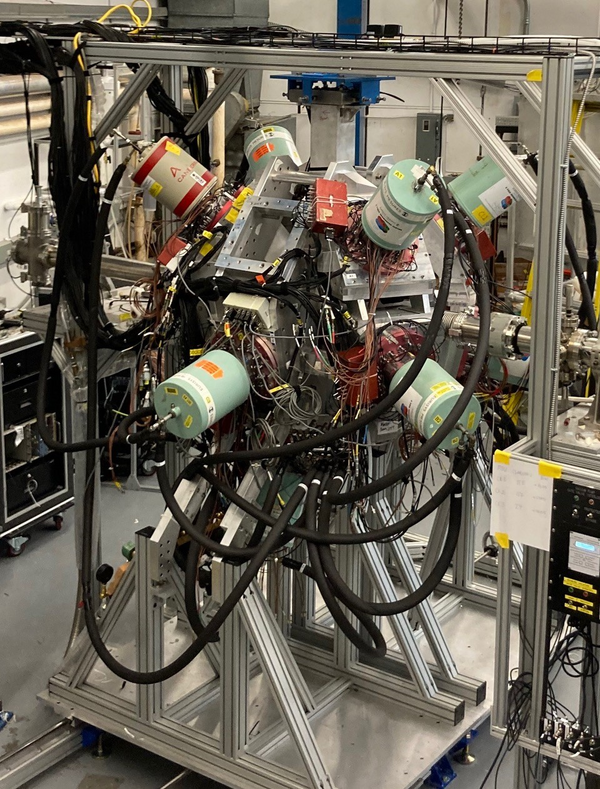
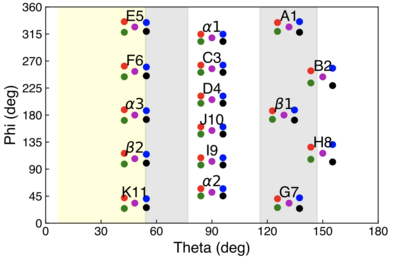
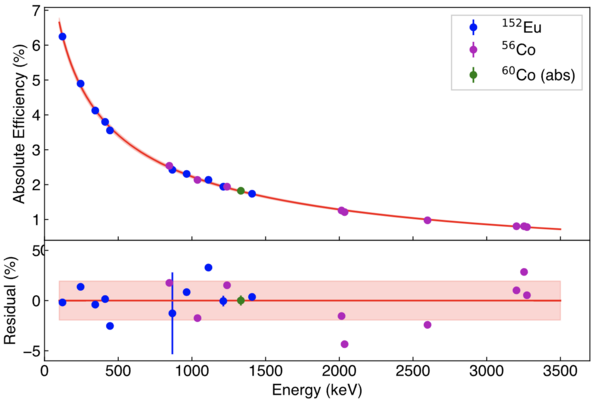
![{\displaystyle \epsilon (e_{\gamma }{\text{[keV]}})=\epsilon _{0}\exp ^{\left(\left(A+Bx+Cx^{2}\right)^{-G}+\left(D+Ey+Fy^{2}\right)^{-G}\right)^{-1/G}},x=\ln \left({\frac {e_{\gamma }}{100}}\right),y=\ln \left({\frac {e_{\gamma }}{1000}}\right)}](https://wikimedia.org/api/rest_v1/media/math/render/svg/64718e1d79fb052bed20be78a1502c342d86c88f)









